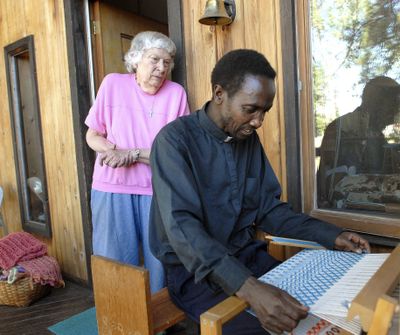Priest, weaver build close-knit bond
He hopes to take newly learned skills back to Kenya

WINCHESTER, Idaho – For about two years now, John Gathungu and Vivian Burns have been weaving a friendship built on shared stories and dreams.
Burns, 80, a master spinner and weaver, and Gathungu, 50, a Catholic priest from Kenya who has lived in Nezperce for about a year, are collaborating on a project they hope will restore some pride in traditional African handicrafts.
On the upstairs porch of Burns’ wooden A-frame home in Winchester, shaded by cool pine trees, the two have been spinning raw wool into yarn and then weaving the yarn into cloth. The results run from simple shawls dyed with food coloring to intricate weavings blending colorful wools, textures and designs.
As Gathungu has gained proficiency in the skill Burns is teaching him, the two have shared stories of faith, family backgrounds and the priest’s plan to help Kenyans relearn some forgotten crafts.
“I was interested to see somebody working with the wool, because (in Kenya) we have sheep but we never make use of the wool,” Gathungu said, recalling meeting Burns for the first time a couple of years ago as she demonstrated spinning at the annual Raspberry Festival at the Monastery of St. Gertrude in Cottonwood. Gathungu served there as a chaplain before moving to the parish at Nezperce.
What surprised him, he said, is that in the United States, which is noted more for its technological leadership, people still practice ancient arts.
Burns, on the other hand, learned spinning and weaving in 1964 from monks at St. Meinrad Arch Abbey in southern Indiana, where her late husband, Bob, was a national park supervisor. Burns said both she and Bob took lessons from the monks, who had been encouraged by Pope John XXIII to share their knowledge and skills with the outside world.
Not being a Catholic, Burns calls herself “vanilla” even though she wears a small wooden cross around her neck. She admits it’s ironic that she has ended up teaching a Catholic priest the skill monks taught her. But the hours she and “Father John” have spent together in the quiet of her upstairs porch have given them lots of time to talk about spiritual things. Amazingly, they both see deeper meaning to spinning and weaving than the simple manufacture of yarn and cloth.
For Gathungu, it’s a possible way to help his people in central Kenya, near the town of Nyahururu, to reclaim old skills that have been lost for generations.
Handicrafts are not much appreciated among Kenyans, and these days they are practiced mainly by rural, illiterate women, Gathungu said.
“To be seen to be doing handicrafts, they would look tedious, unfinished,” he said. “You have something that you have been making for years and you use it. It is ridiculous to use it for ornamental purposes.”
However, unemployment in his part of the world is high. Many young people cannot finish their educations. There are problems with the environment and many people lack useful work to do with their hands.
Gathungu believes if he could return to Kenya and encourage farmers to raise the kind of sheep that produce high-quality wool, then teach young people and others in need of meaningful work to spin and weave, they could use the products themselves and also sell them to countries such as the U.S. where such handicrafts are valued.
“The modern education is not the only way of livelihood,” he said. “If they can use their hands, they can make useful things to make their life better. Not just to market out, but to appreciate their lives.”
Burns, who takes no money for teaching others to spin and weave and said she has no marketing ability of her own, sees in Gathungu validation of what she has come to believe working with one’s hands is all about.
When she and Bob came to spinning and weaving, they were not interested in making money but in learning history – how people survived in years past, how they made their tools, their utensils, their garments. These were universal skills at one time, she said, and the Africans also knew them.
But then came missionaries who taught the Africans that their native skills were wrong and evil, and so discouraged their practice. Now the only place one can see these old crafts is in museums.
Gathungu, Burns said, may be learning something new with his brain, but it’s a skill his hands have always known.
“His hands remember generations ago when people modeled clay and did all the beautiful things that mankind has done in the ages,” Burns said.
“I believe all of us have memory in our hands. We have a hunger for allowing our hands to do what they probably already knew for generations of our forefathers. We inherit a hunger to create. It’s born in us. When it’s taken away, we grieve.”